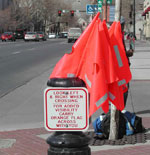Award-winning research means safer ways to cross the street

Why did the citizen cross the road? And more importantly, did he or she make it to the other side unscathed? Whether we’re after a cup of coffee and a croissant or sprinting for the bus, crossing busy streets is an everyday part of urban life.
Researchers at the Texas Transportation Institute (TTI) are studying ways to save the lives of the 5,000 pedestrians we lose nationwide every year. In 2006, TTI completed a project with joint funding from the National Cooperative Highway Research Program (NCHRP) and the Transit Cooperative Research Program (TCRP) to study solutions and make engineering recommendations for pedestrian safety.
“Improving Pedestrian Safety at Unsignalized Crossings – produced through a joint TCRP and NCHRP collaboration – provides considerable information, useful guidance and tools for those interested in improving pedestrian safety at unsignalized crossings,” says Christopher Jenks, director of Cooperative Research Programs, Transportation Research Board. “The report is a testament to the cooperative research process that takes advantage of experts to help develop near-term, practical solutions to problems facing transportation agencies.”
The joint funding between NCHRP and TCRP allowed researchers to study pedestrian safety with an eye toward transit. Bus riders trying to get to their bus stops may have to make a difficult decision to cross the street without a signal, or walk several blocks in the wrong direction to find a signal—something many pedestrians aren’t likely to do.

“We’re looking at ways that we can help people get across streets, particularly at locations that don’t have traffic signals,” says Shawn Turner, TTI associate research engineer. “We studied a variety of different types of signs, pavement markings and traffic and pedestrian control devices.”
The research team, lead by Research Engineer Kay Fitzpatrick, studied 42 sites in seven states to determine how cities and municipalities handled pedestrian crossings at unsignalized crossings.
Change for the better
“One of the project’s objectives was to look at the pedestrian signal warrant and to develop recommendations for changes,” says Fitzpatrick. Warrants are conditions that must be met before an engineer considers installing a traffic signal.

“Our new warrant recommendations were approved for the upcoming edition of the Manual of Uniform Traffic Control Devices (MUTCD),” says Fitzpatrick. “We also recommended a new device for use at pedestrian crossings. Our research found that a pedestrian beacon (similar to a traffic signal, but with a slightly different light sequence and configuration), will cause a high percentage of drivers to yield to pedestrians—as high as 99 percent at some intersections.” The pedestrian beacon is modeled on the “High-intensity Activated crossWalk,” or “HAWK” device developed by Transportation Administrator Richard Nassi for use in Tucson.
Researchers evaluated an interesting variety of pedestrian crossing devices, from the technologically sophisticated HAWK system (see picture) to a simpler system of brightly colored flags pedestrians can use to alert drivers that they are ready to cross the road.
“We looked at nine different devices to improve pedestrian safety,” says Turner. “We also created guidelines that engineers could use to identify appropriate devices for a crossing.”
And the winner is…
The Institute of Transportation Engineers (ITE) recognized the importance of the “Improving Pedestrian Safety at Unsignalized Crossings” project in August of 2006 by awarding TCRP and NCHRP the Transportation Achievement Award for Pedestrians. ITE deemed the work a valuable tool to aid transportation professionals in selecting pedestrian treatments. ITE also recognized the importance of the recommended guidelines, which included a hierarchy of treatments and provided a logical process for selecting treatment types.
“The value of the report is that it finally provides guidance on which treatments are the most effective and should be considered to improve safety at uncontrolled crossings where there is no stop sign or traffic signal and people are trying to cross,” says Nazir Lalani, deputy director of the transportation department for Ventura County, California.
